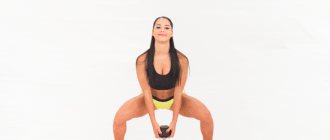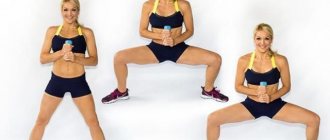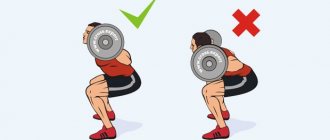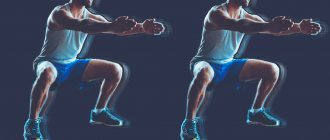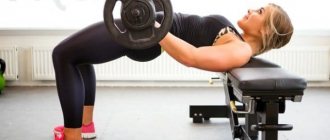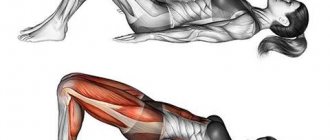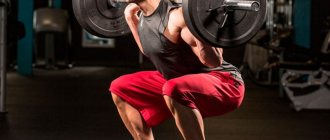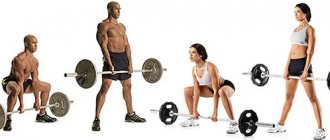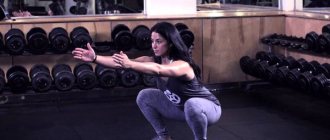There are many types of squats that are successfully used in various strength sports. The specifics depend on the type of apparatus used, the width of the legs, the number of repetitions and other factors. One type of this exercise is plie squats. Let's look at the technique of performing the plie squat exercise.
- What muscles work during plie squats?
- Advantages and benefits of plie squats, difference from sumo squats
- Plie squat with a dumbbell between the legs photo technique
- Video: plie squat technique
- Technique for performing plie with a barbell
- Video: How to do plie squats with a bar correctly
- Recommendations for performing the exercise
Why squat like that?
The most valuable benefit of weighted plie squats is the pumping of the buttocks and inner thighs. Moreover, by varying the depth of the squat, you can use more of the buttocks or quadriceps of the legs. This is relevant for girls who want to pump up their buttocks without particularly increasing the massiveness of their legs. We’ll tell you how to achieve both of these a little later.
Anyone who has already been to the gym knows how girls work on the problematic inner thigh - in a machine for bringing and spreading legs. So, plié needs to be done before this. This is the main exercise for local development of the inner thigh. Then you should get on the simulator. The exercise is designed for dumbbells or weight plates.
How to do it right
The principle is effective for training in the gym and at home, allowing the use of different equipment. The plie squat exercise is suitable for beginners and advanced athletes.
To consolidate each movement in muscle memory, we first hone the technique without implements with the hands crossed on the chest. As we master the practice, we work with weights (dumbbells or kettlebells).
We hold the projectile in straight arms in front of us or lower it down. We grab it with both palms by the end, or, alternatively, by the opposite ends. During the process, we don’t swing it, we don’t change the position of our hands. You can work with 2 dumbbells. We adjust the weight according to personal feelings.
Preparing for the exercise
Have you seen girls in the gym who, with their legs spread wide and holding a dumbbell above the floor, squatted? This is what plié is. For those who haven’t seen it, be patient, everything will be described in detail in the “execution technique” section.
- Stretching is the most important thing in the plie squat. The fact is that you will not be able to turn your knees normally or squat deeply enough if your ligaments are not ready for such an amplitude of movement. Therefore, next we will analyze what and how to pull so that the technique is close to ideal.
- Cloth. A separate conversation about pants. They should not restrict your movements. You need to choose clothes in which you can do the splits. Haven't sat down yet? Everything is ahead, don't be upset.
- Shoes must be stable and have hard soles. If you have weightlifting shoes, you can wear them.
Plie squat technique
In women's training, there are a very large number of variations of this exercise. Starting from the classic version and ending with raising your toes. But in gyms, they are rarely seen. And they are usually done in group fitness classes. We, as people, strive not only to tighten our muscles, but also to increase their volume, giving them an expressive shape. It is the classic version that is interesting. It is the most common and easiest to implement. And at the same time, we can use some tricks to complicate it. But first things first.
Initial position:
- Spread your legs so wide that when you bend your knee, an angle of 90° is formed.
- Turn your toes out to the sides at least 45°. In this case, the knees should point in the same direction as the toes.
- Straighten your back. Retract your shoulder blades as much as possible. This will give your body a more aligned position, making it more difficult for you to deviate from the technique and lean forward.
- Place your hands in front of your chest, palm to palm. Or let it go down. You can also use weights.
- Look forward and slightly upward.
- Tighten your abs.
Performance:
- As you inhale, slowly lower yourself to the bottom. You feel how our adductor muscles are stretched.
- As soon as the pelvis becomes parallel to the floor, as you exhale, begin to straighten your legs. In this case, we will place the load on the heel, and not on the entire foot.
- At the top point, press your legs to tighten the adductor muscles as much as possible.
When working with your own weight, you can fully straighten your knees at the top point. But if you use large weights, it is better to leave them slightly bent and protect your knee joints.
Features of stretching before squats
To perform the exercise correctly, you need to stretch the ligaments of the legs and lower back. We pull the lower back in the classic way - we reach the floor with our hands on straight legs. Here's another good way to stretch your lower back: sitting on the floor. Details in a special article on back stretching.
Leg stretching is best done on a wall bars. Walk up to her and raise your leg as high as you can. Straighten your leg. Bend in different directions, stretch the ligaments. Fix your body in those positions where you experience barely noticeable pain. There is no need to go further.
Sit on the longitudinal and transverse splits. Also, one of the main ways to stretch in this case is to sit on the floor, spread your knees to the sides, and reach them to the floor. Press with your hands from above until your knees touch the floor.
Contraindications and precautions
People who have problems with:
- the spine, especially its lower part;
- knees;
- core muscles.
The load should always be increased gradually. Otherwise, you may experience pain in the lower back, or damage to your knee or hip joints. To avoid unnecessary stress and injury to these parts of the body, the following precautions should be taken:
- Do not straighten your legs completely at the top point - let them remain slightly bent at the knees.
- Do not allow your back to sag - its natural arch should be maintained.
- Make sure that your head is always raised and your gaze is directed forward - many people unconsciously lower their heads and look at the floor.
Exercise technique
The most important thing is to learn how to sit down correctly. Let's start training with the minimum weight that you have in your gym or at home. Let it be a 1 kg dumbbell that you can comfortably grip with your hands.
- We take the dumbbell with both hands so as to hold it by one of the edges. The dumbbell should hang freely perpendicular to the floor, the bar passes between the fingers.
- Place your feet with your toes apart, as if you were a ballerina. Only they place their legs almost together, and you place them a little wider than shoulder-width apart. Turn your socks out to the sides as much as possible. The more the toes are turned out, the more stress will be placed on the inner thigh. In particular, the position of the feet of plie differs from sumo (in sumo, the socks turn about 45 degrees).
- We straighten our back, move our pelvis back a little, creating a natural deflection in the lower back.
- We look slightly upward (usually they suggest looking at the line between the ceiling and the wall that is opposite you).
- We begin to lower the pelvis down. Keep your knees pointing in the same direction as your feet (which is why we warned you that a good stretch will be needed). We squat to the maximum - below parallel with the floor. We don’t swing dumbbells back and forth!
- After reaching the bottom point, we begin to get back up. We go down as we inhale, we rise as we exhale. It is important that the movements are smooth.
- We don’t fully extend our legs! You need to maintain muscle tension throughout the exercise.
- The weight is kept perpendicular to the floor between the legs at all times.
The exercise technique is not the most difficult, but a lot of mistakes are made.
Errors during execution
Too much weight
This is the main mistake that most beginner athletes make. In pursuit of quick results, people do not think about their own safety. And ultimately it all ends in injury. Also, heavy weight greatly affects the technique of the exercise. Because it will pull you too far forward. And ultimately the exercise will turn into sumo squats. But we don't need this. Therefore, be prudent and increase the weight only after you have mastered the previous one for at least 10 repetitions with clean technique.
Look at your feet
It seems that it makes no difference where the athlete looks during the exercise. But it's not that simple. The position of your body depends on where you look. If the gaze is directed forward and upward (as required by the execution technique). Your head will automatically straighten, and your spine will follow. Consequently, our back will be perfectly straight, but if we start looking at our feet, our head will tilt forward. Which will subsequently round our back. And paired with heavy dumbbells, the load on our spine will increase.
Mistakes and how to avoid them
Do you lean forward too much? This happens when you back squat because you are afraid of falling. In this case, you are also afraid of falling. What to do: Place a bench behind you so that you can sit on it as you move down. This will give you confidence and you will remember how to move. Then remove the bench and try squatting lower.
Other errors:
- The knees “walk” from side to side. This occurs when you lack stretching or have weak knee ligaments. Or you haven't spread your feet far enough and are trying to turn your knees even further. The solution is stretching and coordinated work of the knees and feet.
- Looking at the floor. You just need to keep your head straight, or slightly up.
- The dumbbell in your hands dangles between your legs because you strain your arms too much (at first it goes forward, and when your arms get tired, it goes back). Remember, gravity is working for you, it will align your weight perpendicular to the floor. Let Mother Earth do it for you.
- If you don't stand wide enough, your knees may go beyond your feet. It is not recommended to do this in a squat.
- Your legs are fully straightened at the top. This is not recommended, as the muscles relax, but the effectiveness of the exercise decreases. Watch the position of your legs - they should be bent (slightly to maintain tension).
- Shallow squat. The meaning of the exercise is lost when you perform the exercise with a small amplitude. In this case, you use only the front and outer thighs and pump only them. And for this there are special exercises, for example, a front squat. The internal part begins to work when you drop below parallel with the floor.
- This is not a sumo deadlift, so you need to work with your legs, not your lower back. Pay attention to this!
Differences from classic squats and sumo squats?
Of course, comparing regular classic squats and plies is not entirely rational. These are two different exercises. Starting from the position of the legs. We are talking about the width of their production. In the classic version, place your feet shoulder-width apart. The feet are turned slightly to make the position more stable. And ending with the fact that the exercise occurs due to the work of the quadriceps, gluteal muscles and hamstrings. Leading agents are used to a minimum.
But sumo squats are often confused with plies. But these are two different exercises, and they have very significant differences.
- In plie squats, the width of the legs is much wider than in sumo style. This is done in order to stretch the adductor muscles as much as possible.
- In sumo style, the socks are slightly turned out to the sides for greater stability. While in plié we turn our feet 45°. Rotating the toe also affects the level of adductor stretch.
- Plie is performed with a straight back. This way we exclude the gluteal muscles from the exercise. And we can load the adductors as much as possible. In the sumo squat, the main areas for us are the buttocks and the back of the thigh. Therefore, we lean forward a little and push our pelvis as far back as possible.
- Plie squats are a more isolated exercise and don't require too much weight. But in sumo, you have to sweat with a heavy barbell on your shoulders or dumbbells in your hands.
As you can see, plie squats have nothing in common with other types of this exercise. So don't confuse them. And then you will be able to influence exactly those muscles that you planned.
Useful tips
Squat in front of the mirror. You must see yourself. It is clear that you can see better from the side. Believe me, looking at yourself in the mirror, you can also see many mistakes and correct them.
And:
- Don't chase the scales. The inner thighs are easily injured and take a long time to heal. Always warm up with light weights before moving on to heavy weights.
- You can use a weight plate instead of a dumbbell. The only negative is that it is not as comfortable to hold in your hands as a dumbbell. But there is a way out - attach it to a special weight belt. Thus, you can significantly increase your working weights, completely freeing your hands. But you will need to study on platforms (read about this below).
- If your knees hurt, you can try using elastic bandages. In some cases, this does not help, since the squats are deep, and at some point there may still be pain. Focus on how you feel. If you notice a tendency towards increased pain, do not argue with your body - work on a leg abduction machine.
- If during a squat you feel slight pain in the inner thigh, stop doing the exercise immediately! Working through pain will lead to injury. While you are warmed up, the pain is not so severe and you will not realize how much you have damaged the muscle. We recommend that you do not do any exercise that causes this pain for several days. Then try again, or better yet, consult a doctor.
Half squats, also known as partial squats
Half squats are the same classic squats, only with critical, record weights . The weight used in a half squat is 20–30 percent more than the weight of the apparatus in a classic squat. The purpose of the exercise is not so much to increase the strength of muscles and ligaments, but to prepare the central nervous system for heavy weights.
Doing parallel squats with critical weights is not only difficult, but also dangerous . Here half squats help out, the nervous system receives something like preparation for new, yet insurmountable heights.
Although in half squats the load on the lower back is less than when performing classics or, especially Sumo, record weights still carry a high danger, so the importance of safety in this squat cannot be overestimated. An athletic belt, bandages on the knees, help from a spotter, a power rack - all these requirements are practically mandatory. It's better to be overdressed than to be underdressed
.
Half squat technique
I won’t repeat myself ten times, because the half-squat technique is identical to the classic squat technique, with two clarifications: the legs are placed slightly wider than the shoulders, and the amplitude of the downward movement is only 2/3 of the amplitude in comparison with the classic one. Half squats will not work as a separate exercise; they kind of complement the training program, allowing you to reach new pedestals.
It happens when green beginners are afraid to squat deeply and start training their legs from half-squats with weights that are too heavy for themselves. This is definitely wrong! Half squats help experienced athletes move further, step onto a new level. For beginners, it’s better to start with classic squats with light weights.
Many athletes look with disgust at an athlete who does a partial squat. And they often say clever things: “take less weight and do it right. Is this a squat?” Don’t be upset and have pity on such an athlete, he simply doesn’t know enough theoretical information. And don’t look at how cool and healthy he is - most likely pharmacology has made him a monster on the outside and a goner on the inside.
Squats at the upper amplitude are an effective technique for training the nervous system. But, I repeat, this exercise is suitable for experienced athletes, and can cause new stress for trained muscles.
Half squats with a barbell video:
Exercise options
If you want to maximally target your glutes, you need to do a deep squat. It is simply impossible to achieve this while standing on the floor. The weight will hit the floor before you reach the lowest point in the exercise.
There is a version of plie squats on platforms. Their height is different. If you have good stretching, you can safely squat on such platforms.
Technique:
- Position the platforms so that your feet are stable on them in your starting position.
- You can use a dumbbell, but even better - a belt with the ability to weigh it down with weights. This option is more likely for men with good training. You can lift 45 or 60 kg (yes, men also do this exercise as an addition to a regular squat).
- We begin to slowly descend to the highest possible point. We watch our knees so that they do not go to the sides and do not jump over the edge of the foot.
- You can linger at the bottom point for 1–2 seconds. Let's go back. We don’t stop at the top – as soon as we reach it, we immediately go down. Perform the required number of repetitions.
If there is no platform, take large pancakes and place them on top of each other. This way you can set the desired height, reduce or increase it if necessary.
Use 2 benches placed side by side. This option is suitable for low-budget halls. At home, take two low stools or chairs (just make sure they are stable).
Difference between sumo and plie
The differences between sumo and plie squats may be minor, but they are still there:
| Index | Sumo | Plie |
| Body position when performing the element | The body is tilted forward, the pelvis is laid back | The back is straight, the pelvis is in line with it |
| Load on the inner thigh | Less | More |
| Foot placement | Less wide foot spacing | Legs spread very wide |
| Working weight | Ability to work with heavy weights | Limited selection of scales |
| Safety | Safely | There is a risk of injury to the hip joints due to their unnatural position |
Therefore, to build muscle mass in the inner thigh area, sumo will be more effective and safer. This variation of squats allows you to work with heavy weights without causing discomfort to the hip joints. Plie with light weight can be used at the end of the training to consolidate the result.
What happens if you squat only this way?
Definitely, you will strengthen the inner and front part of the thigh, buttocks. You may get a slight increase in muscle mass. Remember, in order for muscles to grow, they need to be stressed. And the plie version is not designed for such weights. Therefore, this exercise cannot be called basic in the literal sense.
Even the ideal execution technique will not give you muscle growth, this is a myth, remember! Only the classics in combination with progressive loads will give you volume. This is important for those who want to pump up something (buttocks, for example), and not just tighten muscles and tone everything.
It is recommended to perform this exercise in combination with squats with a barbell and leg raises in the machine.
What muscles does plie squats work?
But these are not the only muscles that take part. After all, it is impossible to completely isolate a muscle without any auxiliary assistance. These assistants are:
- The quadriceps (quadriceps) is a large muscle mass that occupies the front of the thigh. And consisting of 4 heads. Its main function is to extend the leg and flex the hip. But due to the strong turn of the legs, this muscle receives minimal load.
- Gluteal muscles. This includes the gluteus maximus and minimus. They help stabilize the body and hips. And they take part in the movement itself. But unlike sumo-style squats (this is discussed in more detail later in the article), they receive a slight load.
- Biceps femoris (biceps muscle). Also involved in movement, as we spread our legs wide. Works very well at the bottom of the squat itself.
And in addition to the muscles that relate directly to the lower body. There are those that help stabilize our body.
- Press. Holds the spine, preventing it from bending forward.
- Back muscles. In particular, the spinal extensors support the body, preventing us from falling back. And the rhomboid muscles hold the shoulder blades.
What should the diet be like?
Plie squats are suitable for those who want to lose weight or gain muscle mass. The versatility of this exercise is explained by the correct diet. First of all, the question is the number of calories consumed. If the main goal of exercise is weight loss, it is necessary to reduce calorie intake, but giving up food completely is strictly prohibited. Hunger undermines the body's strength and causes stress, while physical exercise will not strengthen the body, but will deplete it even more. Gaining muscle mass involves eating in excess of calories.
Before playing sports, you need to eat 2-3 hours before, but if your daily routine does not allow you to eat protein foods before exercise, you can replenish your body’s strength with fruits and dairy products half an hour before exercise . After training, you also need to eat, but not immediately - the body must break down the reserve substances. The diet should include poultry, eggs, cottage cheese and seafood, cereals, durum pasta, fruits and vegetables.
Plie squats are a basic exercise that allows you to sculpt your figure. Proper technique, regular exercise and proper nutrition can achieve incredible results.
Within the walls of the “YourRevolution1905” club, we are ready to professionally help you tighten your body and improve your physical shape. Whole sets of exercises developed by certified specialists, nutritional recommendations, “smart” weighing and much more, all this will help you achieve your goal as effectively as possible. For the most effective and quick results, you can train individually (one-on-one with a trainer) or in mini-groups of up to ten people. Come to our classes and we will help you become the best version of yourself!
